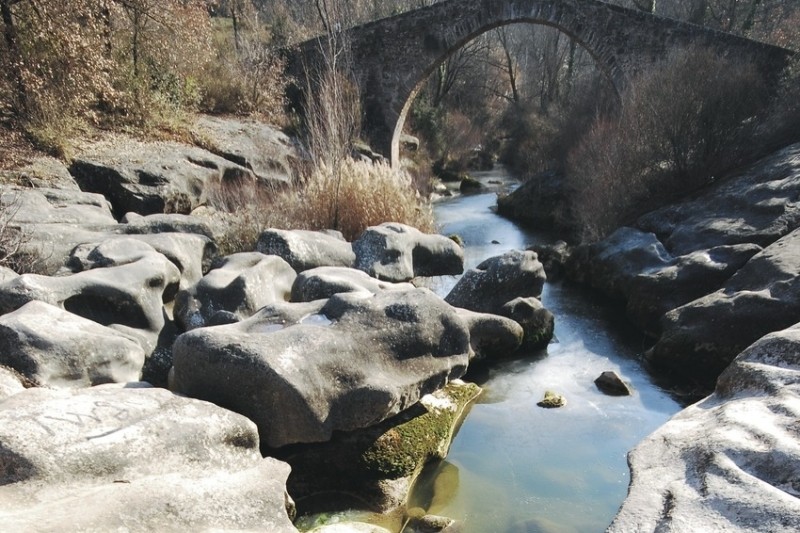Santa Maria de Merlès
The municipality of Santa Maria de Merlès is in the region of Berguedà, in the middle valley of the stream of Merlès The municipality can be divided into two sectors:. the left of the stream, formed by the parish of Santa Maria de Merlès and the right of the stream, formed by San Martin de Merlès, San Pablo de Pinos and San Miguel de Terradellas. The latter sector related to the Lluçanès. For the entire municipality are a good example of Romanesque churches.
The economy is based on agriculture and livestock mainly from pork, beef and cereal crops and forages. As a second activity camping tourism, second homes and agrotourism and gastronomy. As leisure activities include fishing, hunting and hiking.
The stream of Merlès was declared of natural interest to protect otters. Hikers, fishermen and swimmers seek the waterfalls of the stream, rocks and pools where the Lluçanesa tradition places encounters witches. Masías, mills, inns, some camping and some rural accommodation, enliven a wild and beautiful valley, which can be followed by car from the Covered Puigcercós to the neighboring parishes of St. Mary and St. Martin de Merlès, joined by a medieval bridge, while, meeting the bishoprics of Vic and Solsona.
The church of Santa Maria de Merlès was consecrated in 893, and again rebuilt in Baroque style during the seventeenth century. It has a baroque bell classicist trend of solid and sober square base; the two windows on each side are semicircular with the impost of the arches strongly marked, as only decorative element, besides having a gallery crowning balustrade.
The church of San Martín de Merlès was inside the old term Castle Merlès. The origin of the church is because the mid-tenth century the term of the castle was divided in two, using the river as the boundary between them, western sector was in the county of Berga and the diocese of Urgell and lift sector became territory of the county of Osona-Manresa part of the bishopric of Vic; the fact that the parish church of Santa María stay included in the diocese of Urgell must cause the creation of a new church in the term belonging to the bishopric of Osona-Manresa within the limits of the bishopric of Vic: the church of San Martín de Merlès, as documented in the tenth century The current building is the result of a set of transformations undergone by the temple over the years, and has a church with a single nave covered with a barrel vault oriented lift, attached to the steering house; Romanesque construction of the rectangular shape is preserved its original orientation and access to the south wall.
The first news we find the church of San Miguel de Terradellas are from 1011, but the current building is the s. XII and was restored in 1982, it is a Romanesque church with a single nave, 10 x 3'35 m, covered with barrel vault slightly pointed arch of half point, and a semicircular apse with lift. The apse is covered with quarter-sphere and its dimensions are considerable because almost has the same width as the nave of the church. It is built with stone masonry walls partly arranged in regular rows. In the center is a splayed window, covered with an arch monolithic and ornate embossed point, for arquivueltas, with decorations braid rope in his bow. On the west wall is the entrance, restored, framed with stone jambs and lintel molded with the date of 16 + 72 inscribed on the lintel. Inside are preserved, superimposed, the remains of the primitive Romanesque door and baroque door. Above the door there is a window topped by two arches, monolithic lintel inside and outside. Corona rooftop one belfry two eyes, built three stone walls, topped with a wooden deck and Arabic tile twofold, containing a bell from San Miguel again. The old wooden deck, badly damaged, was replaced with an identical new construction.
Church of San Pablo de Pinos we have the first reference year 1169 and the semicircular apse. The church is rectangular and has double slope roof with water on the side walls and is built with stone masonry walls with different corners. On the south side the bell tower, a square where four eyes open (one per side) in the two windows vertically aligned, framed with beveled stone monoliths rising open attached; at the top is the date written 18 + 56.
Nearby routes
See all routes »- The bread in Lluçanès (a 4.4 km)
- The Witches of the Lluçanès (a 4.4 km)
- Looking for mushrooms in Berguedà… (a 4.4 km)
- Route of coca and sausage in Prats… (a 4.4 km)
- A walk through the history of Sant… (a 7.1 km)
What to do
Octavi Guia d'Escalada
Casserres (a 11.2 Km)Meet Octavi Puntas Garcia, a great climbing guide where through ridges, walls…
Centre d'interpretació de l'Església de Cal Pons
Puig-reig (a 8.8 Km)The Interpretation Center of the Colonia Pons Church, through three museum spaces,…
Where to eat
Bar Restaurant Xato
Gironella (a 9 Km)Order pizzas, burgers, tapas... at Xato Bar-Restaurant and we'll deliver them to…
Hostal de Montclar
Montclar (a 17.8 Km)Located in the town square of Montclar, in the south of Berguedà,…
El Recó de l'Avi
Guardiola de Berguedà (a 27.3 Km)Typical homemade cuisine, with oak-grilled meats, a wide variety of tapas and…
Restaurant Gust Picant
Berga (a 15.6 Km)At Gust Picant, you can enjoy affordable menus with a wide variety…
Where to sleep
Cal Fargas Turisme Rural
Santa Maria de MerlèsAt Cal Fargas, comfortable rooms await you in a house surrounded by…
Alberg Cal Pons, Fundesplai
Puig-reig (a 8.6 Km)Discover Cal Pons, a hostel that is part of the architectural complex…
Can Masover Xic
Lluçà (a 10.6 Km)Can Masover Xic is a rural house located in the Rocadenbosch farmhouse…






















